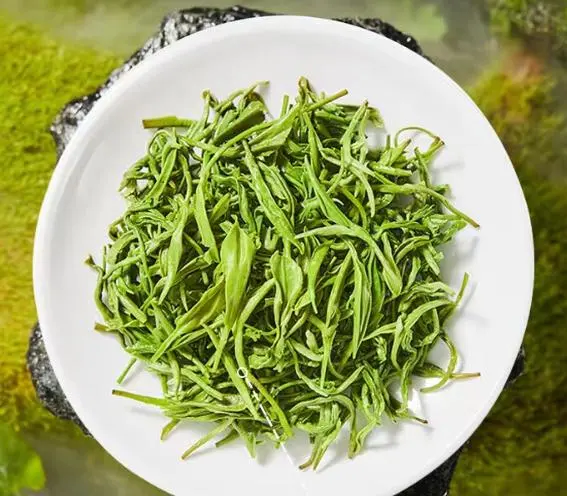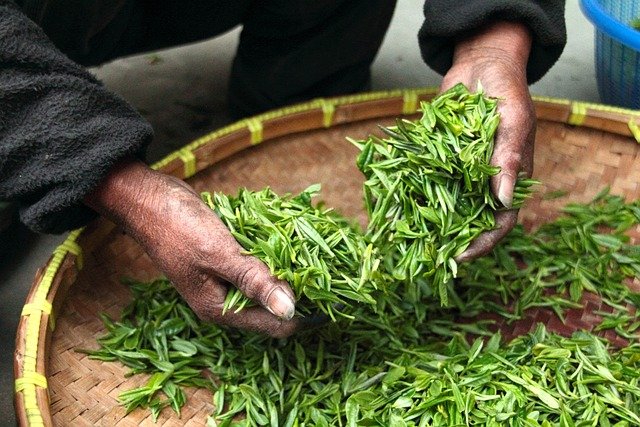Tea is a beverage processed from the leaves and buds of the tea plant. It originated in China and has a long history and rich cultural connotations. According to different seasons, tea can be divided into spring tea, summer tea, autumn tea and winter tea. Although tea is not a “gourmet food” in the traditional sense, it is an indispensable part of my life and a unique delicacy.
1.First Acquaintance with Maojian: The Gem among Teas
Maojian tea, this name sounds full of poetry and elegance. It refers to the tea made from one-bud-one-leaf or one-bud-two-leaf tea shoots after stir-frying and named Maojian. It is known for its slender, straight, round and smooth shape, as well as the fine hairs all over the tea leaves. Whenever seeing those patches of tender green tea leaves, it seems as if one sees the vitality and hope of spring.
The classification of Maojian tea is diverse, mainly dominated by green tea, but there are also some yellow tea types of Maojian, such as Xinyang Maojian. Green tea Maojian, due to its lack of fermentation or mild fermentation, retains the tender green color of the tea leaves and the delicate fragrance of the tea soup.
2.Exploratory Expedition to the Birthplace of Maojian
The production areas of Maojian tea are spread across Jiangsu, Zhejiang, Anhui, Jiangxi, Hunan, Hubei and other places in China. Each piece of land endows Maojian tea with a unique charm.
Xinyang Maojian: Produced in Xinyang City, Henan Province, it is one of the top ten famous teas in China. It is tight, fine, round, smooth, and straight, with silver-green color and hidden emerald hue, and the inner quality has fresh aroma. Whenever I taste Xinyang Maojian, I seem to be able to feel the profoundness of that land and the sediment of history.
Duyun Maojian: Produced in Duyun City, Guizhou Province, it is one of the three famous teas in Guizhou. Its appearance features curly, fine, tight and well-proportioned strips, with obvious fine hairs, fresh and tender aroma, and rich and fresh taste. Duyun Maojian seems to carry the freshness and agility of the mountains, and every sip makes me feel relaxed and happy.
Guzhang Maojian: Produced in Guzhang County, Hunan Province, it is one of the specialties of Hunan Province. Its appearance features tight, fine, round and straight strips, obvious fine hairs, emerald green color and lofty aroma. Guzhang Maojian is like the landscape of western Hunan, elegant and refined, leaving a memorable aftertaste.
Huangshan Maojian: Produced in Huangshan City, Anhui Province, it has thin, round, tight and straight strips in appearance, emerald green color, obvious fine hairs, and lofty and lasting aroma. Huangshan Maojian seems to carry the clouds and celestial air of Huangshan Mountain. Every sip makes one feel as if being in a fairyland.
Baima Maojian: Produced in the Baima Mountain branch of the Xuefeng Mountain Range in Hunan Province, it has tight, fine and well-proportioned strips in appearance, obvious fine hairs and emerald green color. Baima Maojian is like the legendary white horse, mysterious and elegant, making people yearn for it.
The appearance of Maojian tea is thin, straight, round and smooth. The tea leaves are covered all over with fine hairs. The color of the tea soup is emerald green. The aroma is elegant, fresh. The taste is fresh, mellow and sweet aftertaste. Every time brewing Maojian tea is a spiritual baptism.
Characteristics: Maojian tea has unique characteristics in terms of color, aroma, taste and shape. Its tea soup is emerald green like jade, and the aroma is elegant and fresh, as if it can wash away the dust in the soul. The taste is fresh, mellow and has a long sweet aftertaste, leaving people with an unforgettable impression.
Efficacy: Maojian tea is rich in components such as tea polyphenols, amino acids, vitamins, etc., and has the effects of antioxidation, anti-aging, lowering blood pressure, protecting the liver, etc. At the same time, it also has the functions of clearing heat and detoxifying, refreshing the mind, relieving summer heat and quenching thirst. Whenever I feel tired or irritable, a cup of Maojian tea can always restore my calm and vitality.
3.The brewing method of Maojian tea:
Brewing Maojian tea is not only a skill but also an art. Every brewing is a dialogue with the tea and an awakening of the tea’s soul.
Warming the cups: Scald the tea cups with hot water to increase the temperature of the cups and enable the tea leaves to release their aroma better. This step is like giving the tea a warm embrace, allowing it to feel your enthusiasm and anticipation.
Adding tea: Put an appropriate amount of Maojian tea leaves into the tea cups. Generally speaking, 3-5 grams of tea leaves for each cup is enough. Looking at those tender green tea leaves lying quietly in the cups, I seem to be able to feel their life and vitality.
Washing the tea: Brew the tea leaves with boiling water and quickly discard the water. The purpose of this step is to remove impurities on the surface of the tea leaves and also to awaken the tea. The process of washing the tea is like giving the tea a fresh morning, allowing it to radiate new vitality.
Brewing: Inject boiling water again, cover the tea cup, and let it stand for about 1-2 minutes. At this time, the tea leaves slowly unfold in the water, emitting an alluring aroma. I seem to be able to see those tea leaves dancing in the water, releasing all their charm.
Tasting tea: Pour the brewed Maojian tea into the tea cup and taste it gently. When tasting tea, one can observe the color of the tea soup, smell the fragrance of the tea, savor the taste of the tea, and feel the unique charm of Maojian tea. Every time of tea tasting is a spiritual journey that makes me intoxicated.
Maojian tea is not merely a kind of beverage; it is also a part of Chinese culinary culture. In China, tea has countless connections with cuisine. Whether it is the snacks during tea tasting or the combination of tea and meals, they all reflect the Chinese people’s love and pursuit of delicious food. The ancients said, “Tea is the medicine for all diseases.” This not only indicates the health benefits of tea but also reflects the important position of tea in people’s lives. In a busy life, a good cup of tea can always bring us a moment of tranquility and relaxation. And Maojian tea is precisely such a good cup of tea.
To make Maojian tea more delicious, apart from mastering the correct brewing method, there are also some practical life tips to share with everyone.
Choose good water: The water quality for making tea has a significant impact on the taste of the tea. Try to select clear and odorless pure water for brewing tea, as this can better highlight the aroma and flavor of the tea.
Control the water temperature: Different types of tea require different water temperatures for brewing. For Maojian tea, a water temperature of 80-85℃ is the most suitable. Excessively high water temperature will damage the nutrients and aroma components in the tea leaves and affect the taste of the tea.
Drink at the right time: Newly brewed tea should not be drunk immediately. Wait for a while to allow the tea fragrance to fully emanate before drinking. At the same time, do not let the tea steep for too long to avoid the tea soup becoming bitter.
Savoring Maojian tea is not only savoring a kind of delicacy but also savoring a kind of life. It has taught me to slow down, to feel every detail in life, and to experience that tranquility and beauty. In this fast-paced society, we often overlook the beauty around us. However, a good cup of tea can enable us to retrieve that inner peace and satisfaction. Therefore, it is advisable to brew a cup of Maojian tea for yourself in the busy life and enjoy that unique charm and beauty.




